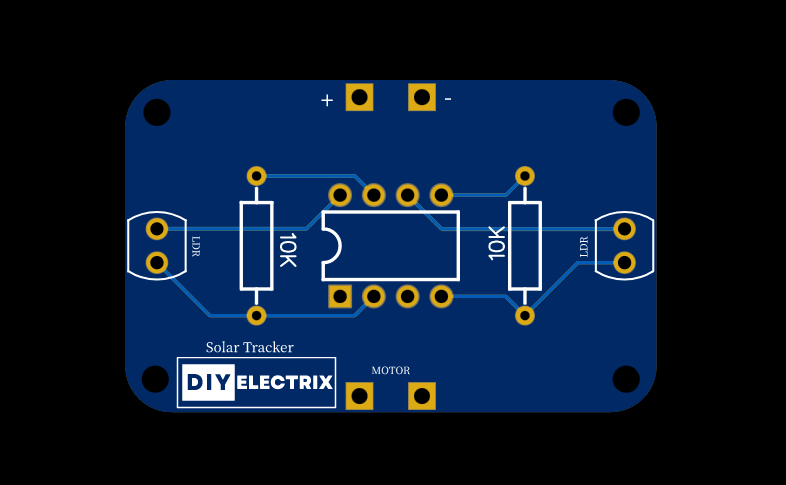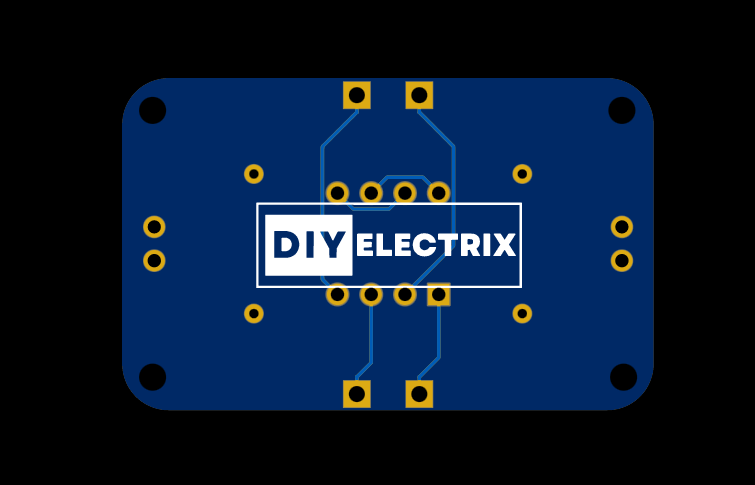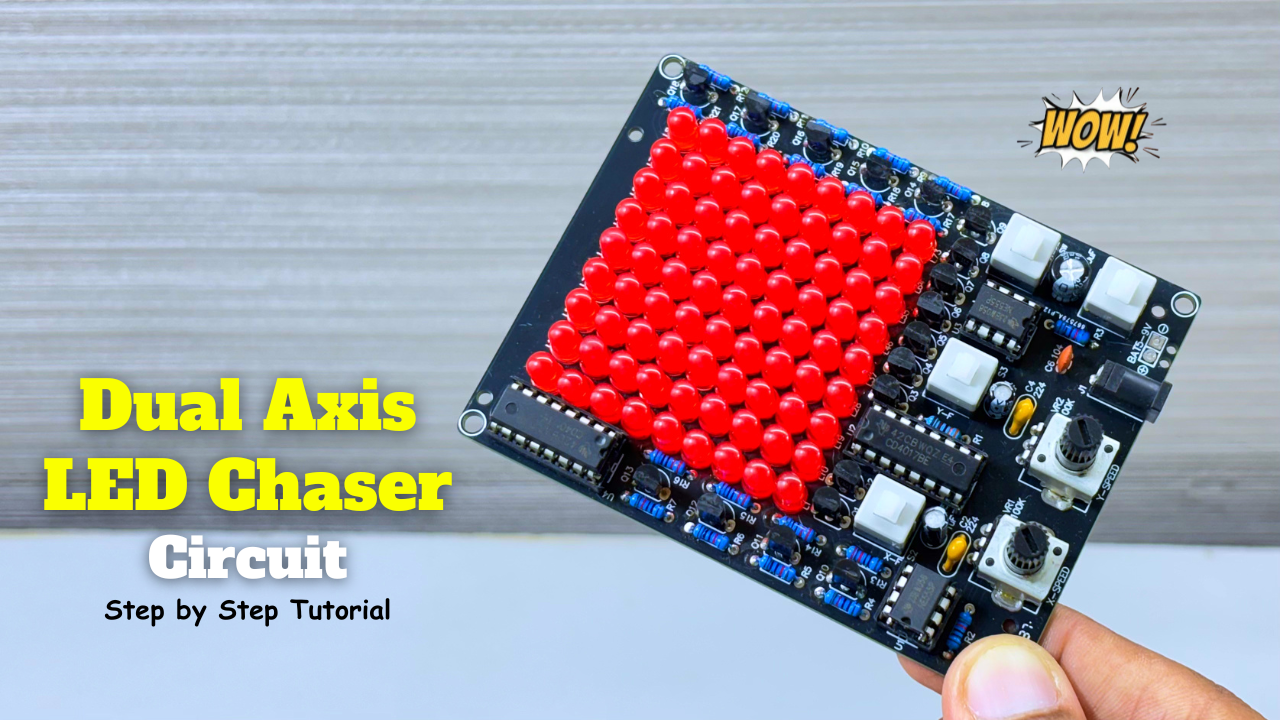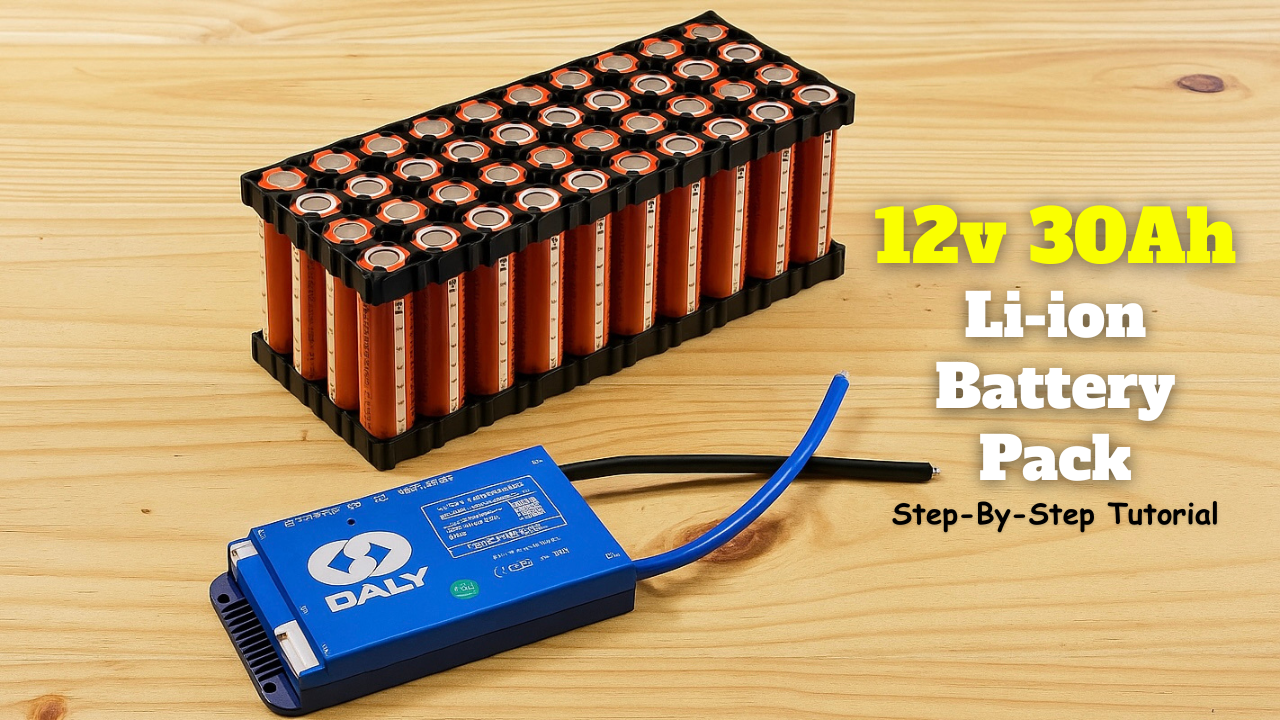A sun tracker is a system designed to orient a solar panel or a solar collector to maximize its exposure to sunlight throughout the day. It typically involves sensors to detect the sun’s position and motors or servos to adjust the angle of the solar panel accordingly.
Components Needed:
- DC Motor or Gear Motor
- TDA2822M IC
- Solar Panel
- 10K Ohm Resistance *2
- LDR *2
- 3.7v Battery
Circuit Diagram:

Special Thanks to Our Sponser – JLCPCB:
No project is complete without the right tool and materials. That’s why our sponser JLCPCB stepped into provide essential material for the project. JLCPCB is a leading provider of high quality printed circuit board and PCB assembling services.
Simply head over to JLCPCB, Upload your gerber file, select specification and just place your order.
48-Hour Turnaround for 6 Layer PCBs!

$0 for 2u” ENIG. Free Via-in-Pad. High Precision. Sign Up to Get $80 New User Coupons.

How To Order PCB
Gerber File:


Solar Panel:
A solar panel is a device designed to convert sunlight into electricity. It consists of multiple solar cells made of semiconductor materials, usually silicon. When sunlight hits these cells, it excites electrons, creating a flow of electricity. Solar panels are grouped together to form solar arrays, which can be installed on rooftops, fields, or even in space to harness solar energy for various purposes, including generating electricity for homes, businesses, and powering devices.
DC Motor:
A DC (Direct Current) motor is a type of electric motor that converts electrical energy into mechanical motion. It operates using direct current, where the flow of electric charge is unidirectional, moving in one direction within the motor’s circuit.
Structure and Components:
- Stator: The stationary part of the motor that typically consists of a frame and one or more permanent magnets or electromagnets.
- Rotor: The rotating part of the motor, usually made of a coil of wire (armature) connected to a shaft. When electricity flows through the armature, it interacts with the magnetic field in the stator, causing the rotor to rotate.
How it Works:
- Magnetic Field Interaction: When a current is applied to the motor, it creates a magnetic field in the armature. This field interacts with the magnetic field generated by the stator.
- Lorentz Force: According to the Lorentz force principle, the interaction between the magnetic fields creates a force that causes the rotor to rotate.
Types of DC Motors:
- Brushed DC Motors: These motors have physical brushes (carbon or graphite contacts) that conduct electricity to the rotor. They are relatively simple but require maintenance due to brush wear.
- Brushless DC Motors (BLDC): BLDC motors use electronic controllers to switch the current direction in the stator windings, eliminating the need for brushes. They offer better efficiency and reduced maintenance.
- Stepper Motors: A specialized type of DC motor that moves in precise, incremental steps. Stepper motors are commonly used in applications that require accurate position control.
Applications:
- Automotive: DC motors are used in various automotive applications, such as power windows, windshield wipers, and electric seat adjustments.
- Industrial: They’re employed in conveyor belts, pumps, fans, and other machinery in industrial settings.
- Consumer Electronics: Used in household appliances like electric shavers, toys, and small devices.
Considerations:
- Voltage and Current: DC motors have specific voltage and current requirements that need to be matched for proper operation.
- Torque and Speed: Different motors offer varying torque and speed characteristics, suitable for different applications.
- Control: Speed and direction of rotation can be controlled by adjusting the voltage or through electronic controllers in modern motors.
- DC motors are versatile and widely used due to their simplicity, reliability, and ability to convert electrical energy efficiently into mechanical motion across a broad range of applications.
LDR:
An LDR, or Light Dependent Resistor, is a type of resistor whose resistance changes in response to the intensity of light. Also known as a photoresistor, it exhibits a decrease in resistance when exposed to higher light levels and an increase in resistance in darkness or low-light conditions.
Structure:
- Material: LDRs are made of semiconductor materials whose electrical properties change when exposed to light
- Construction: They typically consist of a semiconductor material (like cadmium sulfide or other compounds) that exhibits this light-dependent behavior. The material’s resistance decreases as the amount of light on the device increases.
How it Works:
- Light Absorption: When photons (light particles) strike the semiconductor material of the LDR, they excite electrons within the material.
- Conductivity Change: This excitation of electrons alters the material’s conductivity, allowing more current to flow through and resulting in a decrease in resistance.
Applications:
- Light Sensing: LDRs are commonly used in light sensing applications, such as automatic streetlights, where the variation in resistance triggers a response, such as turning lights on or off based on ambient light levels.
- Camera Exposure Control: They have been utilized in older camera systems to measure ambient light and adjust the camera’s aperture or shutter speed accordingly for proper exposure.
Characteristics:
- Sensitivity: LDRs can be sensitive to various wavelengths of light depending on their composition, making them suitable for different light detection scenarios.
- Response Time: They generally have a slower response time compared to some other light sensors like photodiodes, which might limit their use in certain fast-response applications.
Considerations:
- Operating Range: Different LDRs have different operating ranges and sensitivity to light. Selecting the appropriate LDR for a specific application is crucial.
- Voltage and Resistance: LDRs vary in their resistance range, so they might require specific circuit configurations, like voltage dividers, to translate changes in resistance into measurable voltage changes.
- LDRs provide a simple and cost-effective solution for light sensing in various applications, offering a straightforward method to measure light levels and triggering responses based on changes in ambient lighting conditions.
-
Dual Axis LED Chaser Circuit
Components Required: Special Thanks to Our Sponser – JLCPCB: No project is complete without the right tool and materials. That’s why our sponser JLCPCB stepped into provide essential material for …
-
Amazing LED Chaser Circuit – Beautiful Decoration Idea
LED chasers are a fun and creative way to display a sequence of lights. In this blog post, we’ll show you how to build an LED chaser using a 555 …
-
Building a 12v 30Ah Li-ion Battery Pack with Daly BMS
If you’re interested in DIY battery projects, this guide shows how I built a 4S10P (14.8V nominal) battery pack using 40 pcs of 18650 Li-ion cells and a Daly BMS. …



